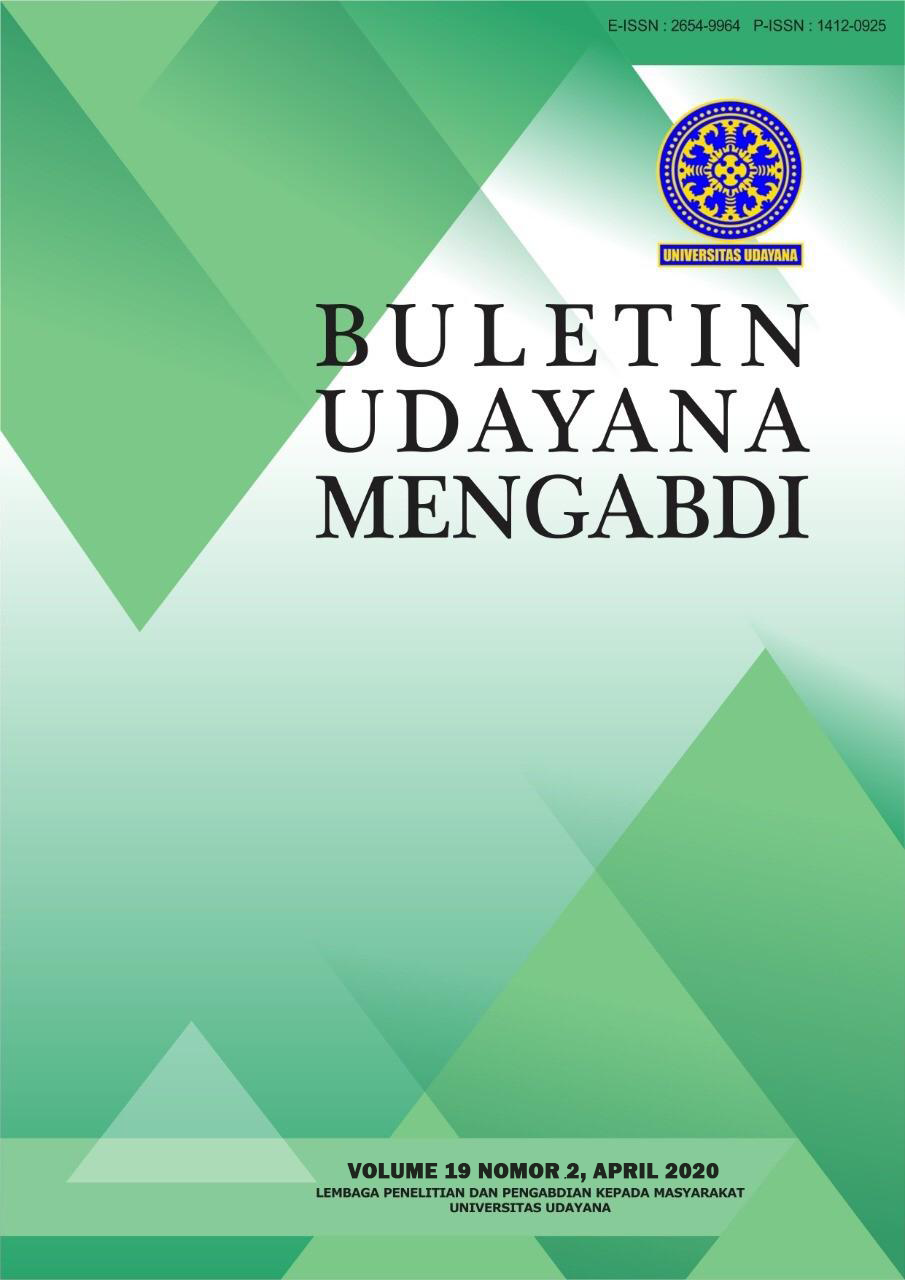PEMBERDAYAAN PETANI DALAM PENCEGAHAN INFEKSI CACING YANG DITULARKAN LEWAT TANAH DI DESA GELGEL, KABUPATEN KLUNGKUNG
Abstract
Abstrak
Infeksi Soil Transmitted Helminth (STH) masih merupakan masalah di daerah endemis di berbagai belahan dunia, terutama di negara yang sedang berkembang dengan sanitasi lingkungan dan kebersihan diri yang sangat kurang. Menurut WHO pada tahun 2017, lebih dari 1,5 miliar manusia atau 24% dari total populasi seluruh dunia terinfestasi STH. Infeksi tersebar di daerah tropis dan subtropis termasuk Indonesia dengan jumlah terbanyak pada daerah sub-Sahara, Afrika, Amerika, China dan Asia. Petani merupakan populasi yang rentan terinfeksi STH oleh karena petani sangat jarang menggunakan alat pelindung diri yang benar, misalnya baju yang menutupi seluruh tubuh, sarung tangan dan alas kaki. Para petani juga tidak menggunakan sabun untuk cuci tangan setelah bekerja dan sebelum makan. Perilaku berisiko ini meningkatkan risiko infeksi STH, oleh karena itu perlu dilakukan upaya untuk meningkatkan pengetahuan dan pemahaman para petani agar dapat meningkatkan higienitas personal dan perilaku hidup bersih dan sehat. Metode yang digunakan dalam pengabdian ini adalah pelatihan dan penyuluhan mengenai cara penggunaan alat pelindung diri dan cuci tangan yang benar agar terhindar dari berbagai penyakit infeksi cacing yang ditularkan melalui tanah. Hasil pengabdian ini terdapat peningkatan pengetahuan dan keterampilan petani dalam menggunakan alat pelindung diri dan perilaku cuci tangan.
Kata kunci: infeksi STH, alat pelindung diri, cuci tangan
Abstract
Soil Transmitted Helminth (STH) infections are still a problem in endemic areas in various parts of the world, especially in developing countries with poor environmental sanitation and personal hygiene. According to WHO in 2017, more than 1.5 billion people or 24% of the total world population were infected by STH. Infections are spread in the tropics and subtropics including Indonesia with the most numbers in sub-Saharan, Africa, America, China and Asia. Farmers are vulnerable to being infected with STH because farmers rarely use proper personal protective equipment, for example clothes that cover the entire body, gloves and footwear. Farmers also don't use soap to wash their hands after work and before eating. This risky behavior increases the risk of STH infection, therefore efforts should be made to increase the knowledge and understanding of farmers in order to improve personal hygiene and clean and healthy living behavior. The method used in this service was training and counseling on how to use personal protective equipment and wash hands properly to avoid various worm infections transmitted through the soil. As a result of this service, there was an increase in farmers' knowledge and skills in using personal protective equipment and hand washing behavior.
Keywords: STH infection, personal protective equipment, washing hands
Downloads
References
2. Biro Humas Provinsi Bali., 2017. Biro Humas dan Protokol Sekretariat Daerah Provinsi Bali. Available at: www.birohumas.baliprov.go.id [diakses pada tanggal 16 Agustus 2017].
3. Dinas Kesehatan Kabupaten Klungkung., 2015. Profil Kesehatan Kabupaten Klungkung, Klungkung: Pemerintah Kabupaten Klungkung.
4. Pemerintah Provinsi Bali., 2010. Peraturan Gubernur Bali No 29. Keberlanjutan Program Simantri, Bali: Berita Daerah Provinsi Bali.
5. Sudarmaja, I., 2011. Epidemologi Infeksi Kecacingan di Bali, Bali: Laboratorium Parasitologi Universitas Udayana.
6. WHO, 2017. World Health Organization. www.who.int/intestinal_worms [diakses pada tanggal 16 Agustus 2017].
7. Mofid, L. S., Bickle, Q. & Jiang, J.-Y., 2011. soil-transmitted helminthiasis in ruralsouth-west china: prevalence, intensity and risk factor analysis. Southeast Asian J Trop Med Public Health, 42(3), pp. 513-526.
8. Ensink, J. H., Hoek, W. v. d. & Mukhtarb, M., 2005. High risk of hookworm infection among wastewater farmers in Pakistan. Transactions of the Royal Society of Tropical Medicine and Hygiene, Volume 99, pp. 809-811.
9. Pham-Duc, P., Nguyen-Viet, H. & Hattendorf, J., 2013. Ascaris lumbricoides and Trichuris trichiura infections associated with wastewater and human excreta use in agriculture in Vietnam. Parasitology International, Volume 62, pp. 172-180.
10. Amoah, I. D., Abubakari, A. & Stenstrom, T. A., 2016. Contribution of Wastewater Irrigation to Soil Transmitted Helminths Infection among Vegetable Farmers in Kumasi, Ghana. PLOS Neglected Tropical Diseases, 10(12), pp. 1-12.
11. Bopda, J., Nana-Djeunga, H. & Tenaguema, J., 2016. Prevalence and intensity of human soil transmitted helminth infections in the Akonolinga health district (Centre Region,Cameroon): Are adult hosts contributing in the persistence of the transmission?. Parasite Epidemiology and Control, Volume 1, pp. 199-204.
12. Sandy, S., Sumarni, S. & Soeyoko, 2015. Analisis model faktor risiko yang mempengaruhi infeksi kecacingan yang ditularkan melalui tanah pada siswa sekolah dasar di distrik Arso, Kabupaten Keerom, Papua. Media Litbangkes, 25(1), pp. 1-14.
13. Widjana, D. P. & Sutisna, P., 2000. Prevalence Of Soil-Transmitted Helminth Infection in the rural population of Bali, Indonesia. southeast asian j trop med public health, 31(3), pp. 454-459.

This work is licensed under a Creative Commons Attribution-ShareAlike 4.0 International License.

This work is licensed under a Creative Commons Attribution-ShareAlike 4.0 International License.




.png)


1.png) GARUDA - GARBA RUJUKAN DIGITAL
GARUDA - GARBA RUJUKAN DIGITAL



